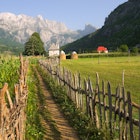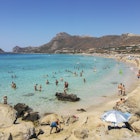
In between beach days, explore Crete’s beautiful national parks
Jul 26, 2022 • 5 min read

On the eastern tip Crete, Vaï National Park is home to Europe’s only native palm forest © Gatsi / Getty Images
Much of Crete’s beautiful scenery feels like a natural reserve – which perhaps explains the small number of officially designated natural parks on the island. But the few that exist all dazzle.
The main national park at Samaria offers one of Europe’s best gorge hikes. While the scenic national park at Vaï lacks official facilities, it is home to Europe’s only native palm forest.
Other protected areas include the vast region of historic villages and geologic wonders at Psiloritis in central Crete, and the gorgeous gem of Elafonisi Islet on the southwest coast, which offers dreamy walks. All worth a day for exploration and enjoyment, these are the best national parks in Crete.
Catch shade under the rare palms at Vaï National Park
Don’t expect elaborate entrances or even a rudimentary visitor center at this national park, which exists primarily to preserve Europe’s only native palm forest. Although barely 20 hectares (49 acres) today, as recently as 1957 Vaï boasted a sprawling palm forest that covered over 300 hectares (740 acres) – before a profit-minded local monastery cut down most of the palms for commercial agriculture and made long-term plans to turn the entire area into a resort development.
Enter the national government, which preserved the remaining palm forest (vaï is Greek for palm) in order to block the bulldozers. Today, the entire area is a wealth of archeological sites, beaches large and small, and tiny villages – although the threat of large-scale development remains.
The palm forest stretches down to the Mediterranean in a small valley running perpendicular to the beach. The shady, whispering fronds are reminiscent of more tropical climates – a rarity in mostly arid Greece. Small coves away from the main beach offer seclusion and serenity throughout the year. Other protected areas around Vaï include Minoan archeological sites.
Visiting Vaï National Park: Regular buses reach Vaï from Sitia, 24km (15 miles) to the southwest. In summer, the main car park fills up early. Get there even earlier or visit at other times of the year, when it will just be you and the palm trees.

Hike the gorge at Samaria National Park
Often referred to as Crete’s only national park, Samaria National Park is the well-organized home to the Samaria Gorge, one of the most popular sights on the island.
From the park entrance in the hillside village of Xyloskalo, an 18km (11-mile) trail descends through almost sheer cliffs to the Mediterranean. Along the way you’ll pass through 500m- (1600ft-) high rock faces that are at times only 3m (9ft) apart. The route is dotted with holy sites and hamlets that were mostly abandoned when the area was designated a national park.
Stay alert for kri-kri, a mountain goat native to Crete. And at the trail’s end, few can resist a dip in the water at Agia Roumeli.
Visiting Samaria National Park: Day trips to the gorge are heavily marketed to tourists across Crete. All start at the park entrance and include a pickup from either Sougia or Hora Sfakion, seaside villages a short ferry ride from Agia Roumeli.
It’s possible to do this on your own combining public buses to and from Hania with a ferry ride, but you’ll have to start very early. In summer, this may be a plus as it will get you on the trail ahead of the day-tripping masses. Families with older children might enjoy the hike.
The park is open from May (occasionally mid-April) to mid-October. After midafternoon, visitors are not permitted to walk the entire trail as everyone needs to be out of the park by 4pm. Sturdy shoes are a must (note the sad faces of those trying to hike in flip-flops). There are spigots along the way with water to refill your water bottle. Drink plenty.

Explore the back roads of Psiloritis Natural Park
Natural, religious and cultural splendors await within this sprawling Unesco Global Geopark in central Crete. A highlight is Moni Arkadiou, a deeply significant pilgrimage destination for Cretans and Greeks in general. In 1866, a band of rebels blew up both themselves and an Ottoman army, sparking Greek resistance to the Turks. The complex includes a surviving grand Venetian church from 1587. Another church, in Thronos, features 14th-century frescoes.
At the south end of the 1159-sq-km (447-sq-mile) park, the Amari Valley is a wonderland of small villages dotted across hills dappled with olive trees, rosemary and other sense-pleasing produce. Historic sites abound in the namesake village and the valley beyond. To the north, Margarites is famous for its pottery workshops. Wait out the morning tour buses and enjoy lunch on a cafe terrace with sweeping views.
To the northeast, a series of caves lie below some of the island’s most dramatic mountain scenery. Melidoni Cave combines both historical significance (the Ottomans committed atrocities here) and geologic beauty (subterranean caverns of stalactites and stalagmites).
Visiting Psiloritis Natural Park: The park is more of a region than a well-defined reserve. The myriad sights are easily reached by car from Rethymno and Iraklio, and driving the winding roads amid the geologic splendor is one of Crete’s highlights. Bus service is more problematic. The larger towns like Margarites have a couple of buses that cruise through daily.

Walk across the water to Elafonisi Islet
The dazzling pink-white sands of Elafonisi on the southwest coast of Crete are already famous – so much so that in high season it can be hard to see the strand for all the polychromatic umbrellas shading the masses. However, an escape lies a mere 50m (164ft) offshore.
Elafonisi Islet is connected to its famous namesake on land by a sandy isthmus that appears at low tide. When the Mediterranean is higher, there is at most a refreshing wade through knee-high water to reach this beautiful mound of dunes. Even when the mainland is crowded, the islet remains nearly devoid of people – one of the reasons it’s popular with nudists. Climb to the highest point on the dunes and you’ll be rewarded with a brilliant spectacle of turquoise water, white sand and rose-hued dunes. The entire islet is a protected natural area, a refreshing change from the busier parts of Crete.
Visiting Elafonisi Islet: For much of the year, the main beach of Elafonisi is best reached with your own wheels; in summer, there is a very limited bus and ferry service. Expect few people anywhere here outside of May to September. In winter, the walk across the water can be more adventurous when there are brisk temperatures and wind-blown waves.
Explore related stories



 ShoppingWhat to buy in a Greek supermarket: from tzatziki to oregano chips and more
ShoppingWhat to buy in a Greek supermarket: from tzatziki to oregano chips and moreSep 16, 2024 • 7 min read






